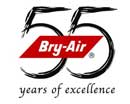|
|
| |
| Humidity Control / Moisture Removal with Bry-Air Dehumidifier |
|
Relative humidity in occupied space should be maintained between 30% - 60% to minimize growth of allergenic or pathogenic organisms. Also, relative humidity in ductwork should not exceed 70% RH to prevent fungal contamination (Mold, Mildew, etc.).
Excessive humidity can damage thebuilding also. |
| Desiccant Dehumidification – for Dry, Healthy Facility |
Desiccant systems remove moisture in a vapour phase.
The air is not saturated as it enters the ductwork, so the supply ductwork is dry.
The dry air prevents fungus and bacteria from growing in coils, ducts and drain pans. |
| use of desiccant dehumidifiers thus becomes the preferred alternative as it provides: |
| » |
Lower Relative Humidity than conventional approach |
| » |
Reduced conventional cooling tonnage requirement |
| » |
Independent control of temperature/humidity |
| » |
Lower energy costs |
|
| The ideal solution is to use desiccant dehumidification in conjunction with energy recovery. |
| Read more... |
| |
| Dehumidifiers on Rental for Short Term Humidity Control needs for Commercial Buildings |
|
TDS provides short term dehumidification & temperature control services for faster concrete drying and water damage restoration. Seasonal high humidity slows down the concrete/POP drying process. Dehumidifiers continuously provide dry air to maintain the moisture content of concrete around 3-5%. This reduces overall project completion time and prevents coating related problems for a longer coating life.
Firefighting activities, Natural disasters, damaged pipes, leakages, human error etc. can cause water damage, which results to immense loss and business interruption to commercial establishments. TDS provides Water Damage Restoration (WDR) services to remove moisture from archives, electromechanical equipment, furniture, carpets, electronic equipment, art, library etc. |
| Read more... |
| |
| IAQ, Odour Control & Energy Recovery, Dry Energy Wheels, Treated Fresh Air |
|
| The quality of Indoor air has a great impact on the well-being and hence the efficiency of occupants of any commercial Building. The plush office complexes, commercial Building, Banks, BP0s, call centres and software complexes are all closed type with no space or very little space for fresh air to enter inside. Moreover, in such conditioned offices, there is re-circulation of stale air which is concentrated with pollutants like carbon-dioxide, mold, bacteria, viruses and chemicals emitted from modern day machines like computers, photocopiers, scanners, etc. |
| |
The Solution to Pollution is Dilution |
The EcoFresh Energy Recovery Ventilator (ERV) exhausts stale, contaminated, conditioned room air and exchanges it with fresh outdoor air, recovering upto 75% energy from exhaust air through a next-generation enthalpy rotor. The EcoFresh ERV is aesthetically designed unit, has low noise levels and can be accommodated even above the false ceiling.
The heart of the Energy Recovery Ventilator is the desiccant coated energy recovery wheel, which slowly rotates between its two sections. In one section, the stale, conditioned air is passed through the wheel, and exhausted in the atmosphere. During this process, the wheel absorbs sensible and latent energy from the conditioned air, which is used to condition (cool / heat) the incoming Fresh Air in the other section, during the second half of its rotation cycle. Thus, you can have more Fresh Air at lower energy costs inside your conditioned space.
|
| Read more... |
| |
| Cooling with EcoCool for large Plant Areas |
| |
| EcoCool Evaporative Cooling Pads as well as standard Evaporative Coolers from Desiccant Rotors International are ideal for cooling large areas. |
| Read more... |
| |
| |
|
| |
| |
|







